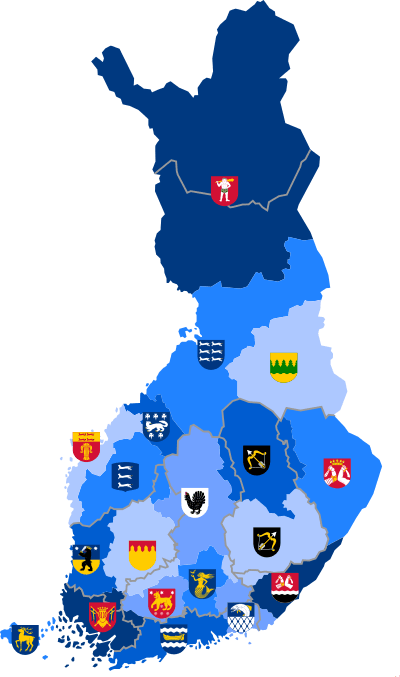Regions of Finland
 |
| This article is part of a series on the politics and government of Finland |
|
Legislative
|
|
|
Finland comprises 19 regions called maakunta in Finnish and landskap in Swedish. The regions are governed by regional councils, which serve as forums of cooperation for the municipalities of a region. The main tasks of the regions are regional planning and development of enterprise and education. In addition, the public health services are usually organized on the basis of regions. Currently, the only region where a popular election is held for the council is Kainuu. Other regional councils are elected by municipal councils, each municipality sending representatives in proportion to its population.
In addition to inter-municipal cooperation, which is the responsibility of regional councils, there are 15 Centres for Economic Development, Transport and the Environment (Finnish: elinkeino-, liikenne- ja ympäristökeskus, abbreviated ely-keskus), which is responsible for the local administration of labour, agriculture, fisheries, forestry and entrepreneurial affairs. They are each responsible for one or more of regions of Finland, and include offices of the Ministries of Employment and the Economy, Transport and Communications and Environment. The Finnish Defence Forces regional offices are responsible for the regional defence preparations and for the administration of conscription within the region.
Regions represent dialectal, cultural and economic variations better than the former provinces, which were purely administrative divisions of the central government. Historically, regions are divisions of historical provinces of Finland, areas which represent dialects and culture more accurately .
Regions
| Coat of Arms | English name | Finnish name | Swedish name | Capital | Map |
|---|---|---|---|---|---|
| |
Lapland | Lappi | Lappland | Rovaniemi |  Regions of Finland (the borders of historical provinces are shown in grey) |
| |
Northern Ostrobothnia | Pohjois-Pohjanmaa | Norra Österbotten | Oulu | |
| |
Kainuu | Kainuu | Kajanaland | Kajaani | |
| |
North Karelia | Pohjois-Karjala | Norra Karelen | Joensuu | |
| |
Northern Savonia | Pohjois-Savo | Norra Savolax | Kuopio | |
| |
Southern Savonia | Etelä-Savo | Södra Savolax | Mikkeli | |
| |
Southern Ostrobothnia | Etelä-Pohjanmaa | Södra Österbotten | Seinäjoki | |
| |
Central Ostrobothnia | Keski-Pohjanmaa | Mellersta Österbotten | Kokkola | |
| |
Ostrobothnia | Pohjanmaa | Österbotten | Vaasa | |
| |
Pirkanmaa | Pirkanmaa | Birkaland | Tampere | |
| |
Central Finland | Keski-Suomi | Mellersta Finland | Jyväskylä | |
| |
Satakunta | Satakunta | Satakunta | Pori | |
| |
Southwest Finland | Varsinais-Suomi | Egentliga Finland | Turku | |
| |
South Karelia | Etelä-Karjala | Södra Karelen | Lappeenranta | |
| |
Päijänne Tavastia | Päijät-Häme | Päijänne-Tavastland | Lahti | |
| |
Tavastia Proper | Kanta-Häme | Egentliga Tavastland | Hämeenlinna | |
| |
Uusimaa | Uusimaa | Nyland | Helsinki | |
| |
Kymenlaakso | Kymenlaakso | Kymmenedalen | Kotka, Kouvola | |
| |
Åland Islands[1] | Ahvenanmaa | Åland | Mariehamn |
The region of Eastern Uusimaa was consolidated with Uusimaa on January 1, 2011.[2]
| Part of a series on |
| Subdivisions of Finland |
|---|
| Regions |
| Sub-regions |
| Municipalities |
See also
- Municipalities of Lapland
- Regions of Northern Finland
- Regions of Eastern Finland
- Regions of Western and Central Finland
- Regions of South-Western Finland
- Regions of Southern Finland
- Municipalities of Åland
- County Councils of Sweden
- Household pennants of Finland
- ISO 3166-2:FI
- Regional State Administrative Agency
References
- ↑ The role that the regional councils serve on Mainland Finland are, in Åland, handled by the autonomous Government of Åland.
- ↑ "Valtioneuvosto päätti Uudenmaan ja Itä-Uudenmaan maakuntien yhdistämisestä" (in Finnish). Ministry of Finance. October 22, 2009. Retrieved December 30, 2010.
External links
| Wikimedia Commons has media related to Regions of Finland. |
- Regional Councils of Finland – Official site
- Regional State Administrative Agencies